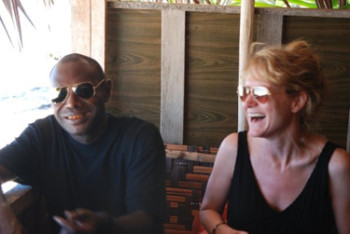
The author and her colleague John Aini. John is the director of Ailin Awarness, a conservation NGO in PNG
The Pig in a Garden: Jared Diamond and The New Yorker Series
Art Science Research Laboratory’s imediaethics.org is publishing a series of essays on the controversy surrounding Jared Diamond’s New Yorker article, “Annals of Anthropology: Vengeance is Ours.” The essay series titled, The Pig in a Garden: Jared Diamond and The New Yorker, is written by ethics scholars in the fields of anthropology and communications, as well as journalists, environmental scientists, archaeologists, anthropologists and linguists, et al. Paige West’s essay is eighth in the series.
* * * * * * * * *
Much has been made of late about a story that Dr. Jared Diamond contends that he heard in Papua New Guinea. He recounted that story in The New Yorker magazine in a section entitled “Annals of Anthropology.” Dr. Diamond was not in Papua New Guinea as an anthropologist when he heard the story in question, nor does he have any training as an anthropologist. Dr. Diamond earned his Ph.D. in physiology and membrane biophysics and over the course of his long and successful career, he has become an expert on ornithology and has traveled to Papua New Guinea numerous times as an ornithologist and an environmental consultant.
We will never know what Dr. Diamond heard on the day, or days, in question, but the way he recounts the story in The New Yorker, as a story about actual facts, tells us that he is not practicing anthropology. As does his attempt to use the story to illustrate a sort of unidirectional evolution of human societies—which is itself a form of storytelling that has been discredited in anthropology for a quarter of a century. We will never know why The New Yorker chose to put Dr. Diamond’s story in the “Annals of Anthropology” section of the magazine but we can take this as evidence that the magazine’s editors have no idea what anthropology is.
The controversy over Dr. Diamond’s article, and the story that it recounts about Papua New Guinea, reminded me of another story, from another part of the country, one that I heard myself.
Joe’s Story
Night has come to Maimafu, a village in the high mountains of the Eastern Highlands Province of Papua New Guinea, and I find myself sitting around a fire with my friends Joe, Kobe, Ruth and Soko (not real names). It is the rainy season and after a late afternoon of cloudbursts the air outside is cool and crisp but inside we are cozy. With the children now sleeping soundly and the cooking fire slowly dying, we adults settle in for a night of talking and telling tales. We meander through various topics before Joe tells the following story:
About two years ago Joe became stranded in a nearby village when the airplane he was flying on had a mechanical problem and was grounded overnight. Maimafu is in a rural, roadless part of Papua New Guinea and is serviced weekly by airplanes owned by various missionary-related air services. These airplanes provide transportation for villagers and carry cash crops, such as coffee, that are grown in rural areas and shipped to markets. Joe spent the night in the village, and the next morning woke up to a commotion on the airstrip. He went outside to see what was happening.
On the airstrip stood a young woman holding a can of kerosene and screaming at two old men. The woman wept as she yelled that she would never go back to her husband, no matter what her family tried to force her to do. As she raved, she began to douse herself in the kerosene. Joe watched in horror as he realized that she had a cigarette lighter in her other hand. He ran through the gathered crowd, tackling the woman, and pulled her into the Mission Aviation Fellowship office near the airstrip.
Once in the office the young woman told Joe her story. Her father had arranged a marriage between her and a wealthy old man who had many wives. The marriage had been arranged when she was a young child, as is the custom among her language group, in order to strengthen her family’s standing against a rival family in an ongoing dispute with another family. Her father and his brothers had wanted to make an alliance with the wealthy man’s family, and she had been part of the agreement. The old man had made a great deal of money mining for alluvial gold as a younger man and turned that money into a vast fortune in Port Moresby, the capital of Papua New Guinea. Once he had made all the money he wanted, he moved back to his village and started marrying .
At first, the young woman was excited to marry . She had become pregnant when she was a teenager and even though she lost the baby, she had been widely shunned and ridiculed. Because of this, she worried that she would never get married and she was initially grateful to find a husband who would take her. But once she got to the old man’s village, she found that her new husband was extremely violent. He drank homemade liquor, smoked marijuana, beat his wives, and forced all of them to have sex with him whenever he wanted. He beat and raped her repeatedly and, finally, when she feared he would kill her, she ran away to her parents’ village. When she got there, her father told her she would have to return to the old man, that he had paid her brideprice and that he and her uncles and others already had transferred the objects and cash paid into other needs. He said she had no choice. The young woman argued bitterly with her father, told him she would rather die than suffer further rapes and beatings. But he would not change his mind.
Joe consoled the young woman and formulated a plan to help: he would offer to marry her and repay the brideprice to the old man so she would be free of this burden. After that, he would bring her to Maimafu, and she could have time to decide whether to remain or go elsewhere. The young woman agreed to the plan, and they went to find her father and his brothers.
Joe and the young woman approached her father and Joe told him the plan. Her father immediately refused, saying that the old man in question was powerful and rich and that he would exact revenge on her family if the young woman did not return to him. Joe tried to talk calmly with her father, explaining that he would smooth things over with the old man. Her father still refused, saying he feared payback from the old man’s extended family. Joe, growing angry, raised his voice. He brought up his own father’s and grandfather’s names, to make sure her father understood who he was. But the father still refused to even consider their plan. As Joe’s rage grew, the young woman became increasingly hysterical. Joe was ready to kill the father because he was being so unreasonable, but as his rage was boiling over, the young woman fled from the house. Joe chased her but she flew into the forest. As Joe went in after her, he quickly became disoriented. He yelled and called to her, to no avail. He and her brothers searched fruitlessly. Finally, after a week, they gave up.
Storytelling and Story Hearing
When anthropologists hear a story like the one Dr. Diamond heard or like the one Joe told, they strive to understand the story itself and what that story says about the world – so much so, in fact, that the story is typically the primary object of investigation, and the events recounted in the story, however interesting, are often secondary. We don’t always try to find out if the story is true or false. Rather we take the story itself as something that can tell us about the social world of the person telling it. Anthropologists see stories as representations that package actual recounting of events with the interpretations and frames of the person telling the story. They create relationships between the person telling the story and the person or people hearing the story. They allow the storyteller to craft a unique version for both the listener and for the storyteller; in other words, they telegraph and produce identity. Furthermore, stories don’t just store information and recount memories; they organize, alter, and produce information and memory. They are also told in a particular context.
A story’s telling – when it is told, who tells it, how they tell it, where they tell it, why they tell it, to whom they tell it, and what sort of story it follows and precedes – is as significant as the story itself. The words used in the story, the verbal inflection performed, the pacing, the pausing, the allowed interruptions and the silenced interruptions, the cadence of the story:All of these things are also important. One of the central things that anthropologists do is collect, analyze, and interpret stories. These stories take many forms: they may be explanations of events; recounting of ancient, recent, or life history; accounts of interactions between families, individuals and/or institutions; or accounts of events in the intangible world of spirits or ancestors, or between the spirit world and the tangible world. No matter what the stories are about or what form they take, they are what anthropologists and other social thinkers have called “narratives,” and all narratives tell us something about a larger social world in which people both find themselves embedded and also make through their own practices, beliefs and storytelling.
The Social Context of the Story
What Joe gave us in the story I recount above is a set of nested narratives: a story within a story within a story, each bearing different elements and meanings. The context in which he told the story also has meaning. Ruth, Maria, Soko and I were not just passive listeners; our presence and our previous conversation had an influence on how Joe told his story. Right before he told the story we discussed a man with twenty-eight wives. The morning before Joe told his story, Soko and I went to a church where the minister gave a sermon about God’s image of a perfect family and the role that men and women have in that family.
The sermon was inspired by events alleged to have taken place earlier that week in a nearby village. Everyone in Maimafu had heard, through the vast social network between and within Gimi-speaking villages – of which Maimafu is one – that a man in that village beat his wife so severely that she had to be evacuated by air to the hospital in Goroka, the capital of the province. Our conversation that night right before Joe told his story weighed the claim that God does not acknowledge polygamous marriages, and touched on the frequency and severity of spousal abuse in Papua New Guinea. When our talk turned to rumors of the man with twenty-eight wives, Joe thought to tell his story.
The context of the conversation in which the story was recounted was that of a social space among friends and family with an outsider present. Joe told the story knowing that I write about the things people tell me when I am in Papua New Guinea. Anthropologists have written much about the ways in which our presence alters, evokes, inspires, transforms and silences. When people tell me a story, I often think about the work of anthropologists who helped the discipline better understand how the presence of outsiders, be they anthropologists, journalists, tourists, missionaries, government officials, or people from a different village or social group, alters the social world we set out to document. We always have to consider that we are part of an audience and that people craft stories to satisfy their audience. How they craft those stories for particular people tells us something about how they see those people and their relationships with them.
Our conversation about Christianity, family, violence against women, and polygamy framed Joe’s telling of the story and our hearing of the story. Because Joe was the only man present that night, he tailored the story for a female audience. He crafted a story in which he is a hero, one showing his modern views on women’s issues. In the story, he offers to save the woman either through marriage or by giving her a safe haven in his village while she ponders her future. He shows that he is socially enlightened yet at the same time fulfills proper gender roles of standing up to people who take advantage of others, of expressing his anger openly and eloquently through discussion, and of taking charge of a situation and attempting to turn it in a way that diffuses conflict.
The story also offers a standard and well-worn critique of the social practices of people from the young woman’s family’s language group. Gimi territory is adjacent to the territory of these people, and Gimi see them as rural, backwards and underdeveloped. They tell jokes about them, disdain their traditions (especially the one that they understand to dictate the promising of young girls to older men, who over time work to support the girl’s family and her upkeep in order to marry her when she comes of age), accuse them of sorcery, accuse them of trespassing, accuse them of not maintaining historical alliances against common enemies, and in general speak very poorly of them. This is a source of ambivalence because several of the villages in this language area are connected to Maimafu through the exchange of women. Joe’s mother is from one of these villages and one of his wives is from that same village, but he is adamant that he would never marry one of his daughters to that village because he wants a better life for his girls than that. This echoes the narrative of individual heroics in Joe’s story: He is a hero in the story, as Gimi men are heroes, in that they save women from living in these places.
Joe’s story also moves through some of the topics that cause my friends in Maimafu the most anxiety: suicide, violence, warfare, payback, gold mining, rape, alcoholism and drug addiction. By highlighting all these issues in one story, Joe articulates the constant worry and fear he and others have about what will happen when these things converge. Gone is the social world in which Joe, who is about forty years old, was raised. He,his parents and their parents grew up in a world organized by a set of rules and practices that defined gender roles, that regulated behavior with regard to the use of resources, that maintained and organized a steady albeit sometimes tense peace between rival families or clans, and that offered everyone a place inside society with a particular role to fill. Today these rules and practices have changed, and in some senses, broken down.
One example of this is the breakdown in behavioral norms and regulations for young men since the various Christian churches working in the area outlawed the practices associated with male initiation, declaring them sinful. Today teenage boys don’t have much to occupy their time. Unlike teenage girls, who are expected to act as young mothers looking after their younger siblings and working with their female relatives to garden, cook and clean, young men spend much of their time playing cards and roaming Gimi territory visiting friends and relatives in other villages. These boys get into fights, drink, try drugs and assault young women. More worrisome for some older Gimi, they also feel disaffected and out of place in the Gimi social world. By articulating all of these elements in one story, Joe is describing Gimi anxiety in general.
Joe’s story also expresses deeply felt Gimi ambivalences about changing social practices or traditions in the modern world. The story touches on the topic of polygamy gone wild in a social context in which polygamy, which Gimi still practice, is increasingly looked down upon by urban Papua New Guineans and the state and is forbidden by the Christian churches operating in the Highlands. Joe has four wives, two of whom were present when he told the story. By casting polygamy as a refuge for the young woman, Joe cleverly articulates the argument that a household with many women married to one man provides a strong and safe network for women and gives the man local and regional power and status, thereby allowing him to help others. If Joe didn’t have other wives who tie him to a vast kinship network across the region, he could never offer to take on a man as powerful as the young woman’s husband. Joe is not wealthy like the woman’s husband but he carries the power and strength of deep regional alliances with him. These alliances are built upon his polygamy, so his story also illustrates a second argument for the value of polygamy, one tied to the maintenance of regional peace through the exchange of women.
The role and treatment of women in society is another constant source of ambivalent feelings for contemporary Gimi.
Traditionally women’s power base in society was in their role as mothers, through growing and providing food, through their importance in maintaining regional and local alliances through arranged marriages, and through their roles in the traditional myths and stories that helped Gimi understand their cosmological place in the universe. Historically, Gimi were shifting horticulturalists who depended on the cultivation of sweet potatoes and taro for the bulk of their diet. Women were in charge of all cultivation and they practiced a sort of garden magic that allowed for crops to be plentiful and full of the nutrition people needed to become productive members of society.
This magic was intimate and secret and included songs and stories that women would sing to their crops and their babies to make sure they, too, would grow and thrive. When Christian missionaries came to Gimi territory, in addition to targeting initiation ceremonies, they deemed women’s garden magic “satanic” in nature and assured Gimi that both tubers and babies grew because of biology, not because of women’s special powers of reproduction. They also devalued women in general by linking them with Satan and Original Sin.
The view of women in Gimi society has also changed as Gimi have become increasingly enmeshed in the world economy. Since the early 1950s, Gimi have earned cash for growing coffee for the international market. Coffee production was one of the earliest economic development projects offered to people in the Highlands to incorporate them into the emerging nation state of Papua New Guinea. As cash has made its way into the Gimi world, social exchanges that would have at one time involved sweet potatoes, pigs, pearl shells and other objects are now made up of cash transactions. Brideprice, originally a set of transactions between a man’s family and his wife’s family meant to compensate and thank the woman’s family for the love, labor and life they put into a young woman as she grew up and that were meant to cement the bonds between the two families, has become more of an economic exchange today and less of a social one.
Now that money is the main medium of exchange for Gimi, fathers calculate a monetary value on their daughters based on the money spent on her as she grew up. If a daughter went to school, if she had to receive significant medical care, if she costs her father and his family in any way, this is reflected in the calculation of her brideprice. A man’s family now might have to come up with thousands of Kina (the currency in Papua New Guinea) to secure a wife for a son, and once a young woman goes to live with his family after marriage she may be seen as having to pay back the money through her labor. This has subtly shifted how women are valued in society, has directly affected how much labor women are expected to do in society, and causes tremendous anxiety for women and their families.
Joe’s story expresses these ambivalences through a tale that shows what happens when women have no value. Joe has three daughters and worries constantly about the violence they may face later in their lives. He worries about rape, beatings, who will marry them, whether he should send them to school or not (given that this will force their brideprice up and with this ensure that their husband’s families see them as having to repay that cost through labor). Joe concluded his story that night by telling us that about two months earlier he had seen someone he thought was the young woman in a bar in Goroka working as a prostitute. He said that he had approached her, but her eyes were empty and black from drinking and drugs. He said it broke his heart.
Understanding
Dr. Diamond’s article in The New Yorker uses a story allegedly recounted to him by a Papua New Guinean man about the Southern Highlands of Papua New Guinea to make a set of claims about humanity in general. Those claims hinge on a belief that societies evolve over time in a predetermined pattern. This way of thinking is based on social theory from the 19th century that argued that all societies move through certain stages beginning with primitivism and culminating in a form of civilization akin to Western European culture. This set of theories has been completely discounted in the social sciences. Dr. Diamond argues that contemporary rural societies worldwide, like Gimi society in Papua New Guinea, exist outside of the control of government in a state of warfare, murder, suspicion, savagery, violence and vengeance. He argues that “modern state societies rate as exceptional by the standards of human history, because we instead grow up learning a universal code of morality that is constantly hammered into us: promulgated every week in our churches and codified in our laws,” and that as state governments evolved over time, societies were better able to regulate vengeance and violence. Dr. Diamond argues that because the modern state was brought to Papua New Guinea and didn’t arise there independently it has no control over its citizens and that they therefore are prone to extreme and unregulated acts of vengeance and violence.
Dr. Diamond claims that his late father-in-law, a man who apparently suffered some of the most terrible violence in modern history with his and his family’s interment in the German concentration camps during the Second World War, was able, at a crucial personal crossroads, to choose not to commit a violent act of vengeance himself. Dr. Diamond argues that his late father-in-law was able to abstain from violence because of his incorporation into a modern state. The losses that Dr. Diamond recounts his father-in-law having suffered are heartbreaking. However, when he shifts his narrative about family and loss to using a story from Papua New Guinea to explain why when his father-in-law faced the man who had killed his mother, sister and niece, he turned the other cheek, he simultaneously misunderstands the role of storytelling in the Highlands of Papua New Guinea and casts the region’s residents as savage animals who know only vengeance and violence and who are locked in a primitive stage of social evolution.
Dr. Diamond argues that it is the modern state and modern religion that regulate vengeance and violence and that give individuals social roles and outlets for extreme emotions. Yet Joe, through his story, offers a radically different interpretation of states and religions. Joe used a set of socially significant elements, events, actors, images and symbols to offer a critique of the state and religion while at the same time explaining a set of constant anxieties and ambivalences he and his fellow Gimi live with on a day-to-day basis. Joe’s story may or may not be true but in telling it he did not mean to covey truth but rather to communicate an entire social world to the listeners. This is something that anthropologists understand very well.
Author Biography
Paige West is the Curator for the Pacific at the American Museum of Natural History and a tenured professor of anthropology at Barnard College and Columbia University. She has conducted research in Papua New Guinea since 1997 and has spent forty-six months living in Maimafu village.
In 2002, Dr. West received the American Anthropological Association’s Anthropology and Environment Junior Scholar award for her work; in 2004, she received the American Association of University Women Junior Faculty Fellowship and the American Council of Learned Societies Faculty Fellowship; in 2006, she received the Rockefeller Foundation’s Bellagio Fellowship; and in 2007, she was named a Fellow by the Association of Social Anthropology in Oceania. Dr. West is currently the president-elect of the Anthropology and Environment Section of the American Anthropological Association.
Dr. West has published widely: In her first book, Conservation Is Our Government Now: The Politics of Ecology in Papua New Guinea (Duke University Press, May 2006), she examined the exportation of Euro-American ideas about the suitable relationship between the natural and cultural world to rural areas in Papua New Guinea and explored how these ideas produced particular kinds of socio-cultural institutions and physical spaces. In her second book, From Modern Production to Imagined Primitive: Crystallizing Coffee from Papua New Guinea, which will be published by Duke University Press in 2010, , she analyzes the global circulation of coffee beans as valuable meaning-filled agricultural commodities and social vessels for particular symbolic representations of nature and culture and also examines notions of ethnical consumption through fair trade and organic certification. Dr. West has also published articles in The Contemporary Pacific, American Anthropologist, Current Anthropology, Conservation Biology, and the Annual Review of Anthropology, among other places.
In Dr. West’s current project, Making Value in the Pacific Tropics, she considers how particular animals and plants come to have value and meaning for people living in both tropical forests and cosmopolitan global cities. This project has two parts. the first part is focused on animals, value, and the globalization of particular ideologies of nature and culture. The second part is focused, generally, on plants, value, and contemporary attempts to counter global climate change through the seemingly ethnical consumption of biofuels.
Dr. West’s research and scholarship have been supported by Barnard College, The WennerGren Foundation for Anthropological Research, The National Geographic Society, The Christensen Fund, The National Science Foundation, the American Association of University Women, the American Council of Learned Societies, The Rockefeller Foundation, and Columbia University’s Institute for Social and Economic Research and Policy.
Hearing a Story like an Anthropologist
I heard “Joe’s” story through a set of intellectual filters that come from spending a great deal of time in Papua New Guinea and Maimafu, from reading ethnographic books and papers about Papua New Guinea, from reading anthropological books and papers about other parts of the world, from reading non-region specific books and papers that build anthropological theories, and from being trained in anthropological and other social scientific methods of research and analysis.
As a social scientist I heard Joe’s story through sociologist Catherine Kohler Reissman’s extraordinary book Narrative Analysis as well as that of psychologist Jerome Bruner, anthropologists Vincent Crapanzano, Elizabeth Povinelli, Renato Rosaldo, and Clifford Geertz, historian William Cronon, philosopher Stephen C. Pepper, and literary critics Mikhail Bakhtin and Roland Barthes. All of these people, in various ways and with various forms of analysis, interpretation and conclusions, write about how stories or narratives tell us about the beliefs, desires, theories and values held by the storyteller and by her or his society.
As an anthropologist who works in Papua New Guinea I heard Joe’s story through the work of my anthropological colleagues, people who all write about gender like Holly Wardlow, Martha Macintyre, Bruce Knauft, David Lipset, Marilyn Strathern, Gilbert Herdt and Rena Lederman, people like Deborah Gewertz and Frederick Errington who write about modernity, people like Joel Robbins and Jerry Jacka who write about Christanity and religion, people like Aletta Biersack, Dan Jorgensen and Jamon Halvaksz who write about mining, people like Richard Scaglion, Paul Roscoe, who write about warfare and violence, and people like Shirley Lindenbaum, Roy Wagner, Robin Hide, Joshua Bell and David Ellis, who all work in places that border Gimi territory and whose work makes me think about regional relationships.
To learn more about any of these authors specifically or how anthropologists and other social scientists approach storytelling and narrative analysis click on any of the links above.






Comments Terms and Conditions